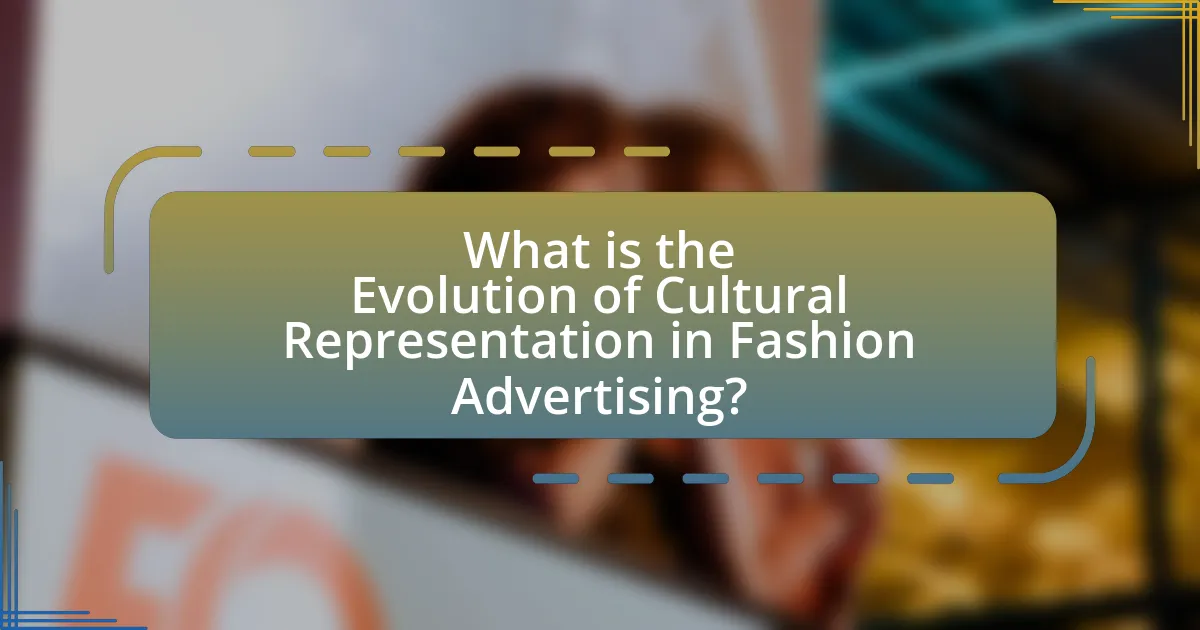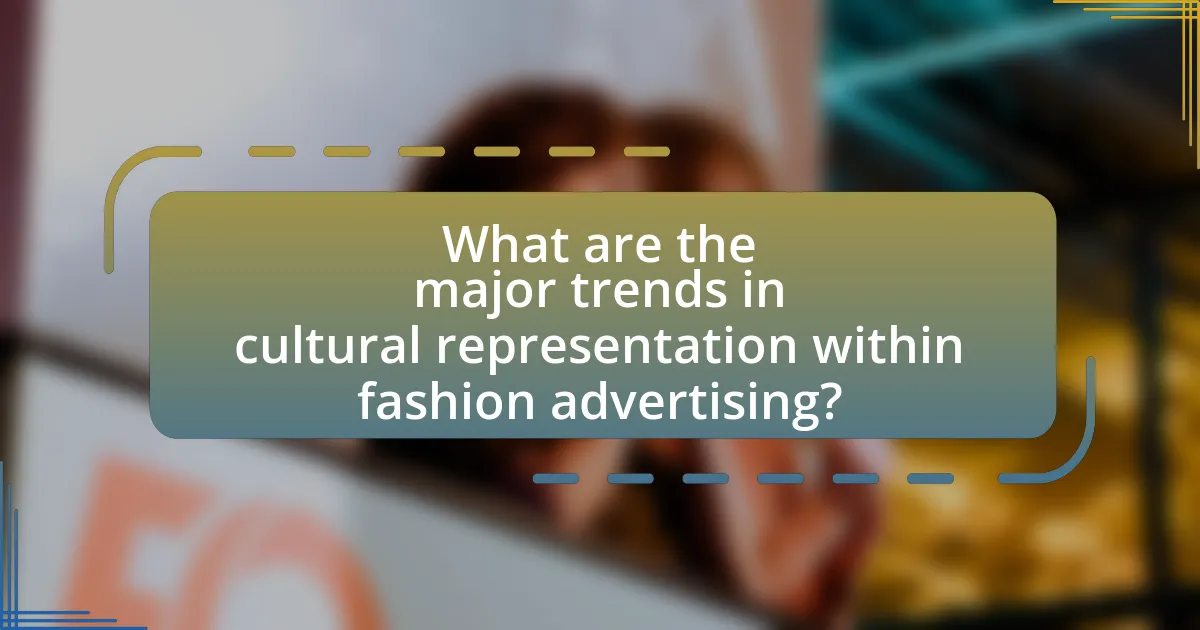The article examines the evolution of cultural representation in fashion advertising, highlighting the shift from Eurocentric ideals to a more inclusive portrayal of diverse cultures. It discusses key historical events, such as the Civil Rights Movement and the rise of social media, that have influenced this transformation. The article also addresses the importance of authentic representation, the impact of societal attitudes on advertising strategies, and the role of digital platforms and influencers in promoting diversity. Additionally, it outlines challenges such as stereotyping and cultural appropriation, while providing best practices for brands to enhance their cultural representation efforts.

What is the Evolution of Cultural Representation in Fashion Advertising?
The evolution of cultural representation in fashion advertising reflects a significant shift from Eurocentric ideals to a more inclusive portrayal of diverse cultures. Initially, fashion advertising predominantly featured white models, reinforcing narrow beauty standards and cultural stereotypes. Over the decades, particularly from the 1980s onward, there has been a gradual increase in the representation of various ethnicities and body types, driven by social movements advocating for diversity and inclusion.
For instance, the 1990s saw the emergence of supermodels like Naomi Campbell and Tyra Banks, who challenged traditional norms and broadened the scope of representation. In recent years, brands such as Fenty Beauty have set new standards by showcasing models of all skin tones and backgrounds, emphasizing the importance of cultural authenticity. This shift is supported by research indicating that diverse representation in advertising positively impacts consumer perception and brand loyalty, as highlighted in studies by the American Psychological Association.
Overall, the evolution of cultural representation in fashion advertising illustrates a growing recognition of the importance of inclusivity and the impact of societal changes on marketing strategies.
How has cultural representation changed in fashion advertising over the decades?
Cultural representation in fashion advertising has evolved significantly over the decades, transitioning from a predominantly Eurocentric focus to a more inclusive portrayal of diverse ethnicities and body types. In the 1960s and 1970s, fashion ads primarily featured white models, reflecting societal norms and beauty standards of the time. By the 1980s and 1990s, brands began to incorporate models of color, influenced by movements advocating for diversity and representation, such as the civil rights movement.
In the 2000s, the rise of social media further accelerated this change, as brands faced pressure from consumers to showcase a broader range of identities, including different races, sizes, and gender expressions. For instance, campaigns like Dove’s “Real Beauty” launched in 2004 highlighted real women of various shapes and ethnic backgrounds, marking a significant shift in advertising strategies.
Recent years have seen brands like Fenty Beauty, founded by Rihanna in 2017, set new standards by offering products for a wide spectrum of skin tones, thereby emphasizing the importance of representation in marketing. This evolution reflects a growing recognition of the need for authenticity and relatability in fashion advertising, aligning with societal changes towards inclusivity and acceptance.
What key historical events influenced cultural representation in fashion advertising?
Key historical events that influenced cultural representation in fashion advertising include the Civil Rights Movement of the 1960s, which led to increased visibility of African American models and themes of diversity in advertising. The feminist movement also played a significant role, particularly in the 1970s, as it challenged traditional gender roles and promoted body positivity, resulting in more inclusive representations of women in fashion. Additionally, the rise of globalization in the late 20th century expanded the reach of fashion brands, prompting them to incorporate diverse cultural elements to appeal to a broader audience. These events collectively shaped the narrative and imagery used in fashion advertising, reflecting societal changes and the demand for representation.
How have societal attitudes towards diversity impacted fashion advertising?
Societal attitudes towards diversity have significantly transformed fashion advertising by promoting inclusivity and representation of various ethnicities, body types, and gender identities. This shift is evident in the increasing use of diverse models in campaigns, reflecting a broader societal demand for authenticity and relatability. For instance, brands like Savage X Fenty and Aerie have gained acclaim for their commitment to showcasing models of different sizes and backgrounds, which has resonated with consumers and led to increased sales. Research by McKinsey & Company indicates that companies with diverse teams are 35% more likely to outperform their competitors, highlighting the commercial benefits of embracing diversity in advertising.
Why is cultural representation important in fashion advertising?
Cultural representation is important in fashion advertising because it fosters inclusivity and reflects the diversity of consumers. By showcasing a variety of cultures, fashion brands can connect with a broader audience, enhancing brand loyalty and consumer trust. Research indicates that 67% of consumers consider a brand’s commitment to diversity when making purchasing decisions, highlighting the impact of representation on consumer behavior. Furthermore, accurate cultural representation can combat stereotypes and promote understanding, contributing to a more equitable society.
What role does cultural representation play in consumer perception?
Cultural representation significantly influences consumer perception by shaping brand identity and fostering emotional connections. When brands authentically represent diverse cultures, they enhance relatability and trust among consumers, leading to increased brand loyalty. Research indicates that 64% of consumers are more likely to purchase from brands that demonstrate cultural inclusivity in their advertising (Nielsen, 2019). This connection is particularly strong among younger demographics, who prioritize social responsibility and representation in their purchasing decisions. Thus, effective cultural representation not only reflects societal values but also drives consumer engagement and purchasing behavior.
How does cultural representation affect brand identity and loyalty?
Cultural representation significantly influences brand identity and loyalty by shaping consumer perceptions and emotional connections. When brands authentically reflect diverse cultures in their advertising, they foster inclusivity and relatability, which enhances brand identity. For instance, a study by the American Psychological Association found that consumers are more likely to develop loyalty to brands that represent their cultural backgrounds, as this representation validates their identity and experiences. Furthermore, brands like Fenty Beauty have successfully leveraged cultural representation to build a loyal customer base, demonstrating that inclusive marketing strategies can lead to increased brand affinity and consumer trust.

What are the major trends in cultural representation within fashion advertising?
Major trends in cultural representation within fashion advertising include increased diversity, the use of authentic storytelling, and a focus on inclusivity. Increased diversity is evident as brands feature models from various ethnic backgrounds, reflecting a broader spectrum of cultural identities. Authentic storytelling has gained traction, with brands emphasizing narratives that resonate with specific cultural experiences, thereby fostering a deeper connection with audiences. Additionally, the focus on inclusivity extends beyond race to encompass body types, gender identities, and age, as seen in campaigns by brands like Aerie and Savage X Fenty, which promote body positivity and representation. These trends are supported by research indicating that consumers are more likely to engage with brands that reflect their values and identities, highlighting the importance of cultural representation in driving brand loyalty and sales.
How have digital platforms transformed cultural representation in fashion advertising?
Digital platforms have significantly transformed cultural representation in fashion advertising by enabling diverse voices and perspectives to be showcased more prominently. These platforms, such as social media and e-commerce sites, allow brands to reach a global audience and engage with consumers directly, facilitating the inclusion of underrepresented cultures and identities in marketing campaigns. For instance, brands like Savage X Fenty and Aerie have utilized digital platforms to feature models of various ethnicities, body types, and gender identities, reflecting a broader spectrum of cultural representation. This shift is supported by data indicating that 67% of consumers prefer brands that promote diversity in their advertising, highlighting the demand for authentic representation.
What impact do social media influencers have on cultural representation?
Social media influencers significantly shape cultural representation by amplifying diverse voices and perspectives that were historically marginalized in mainstream media. Their platforms allow for the promotion of various cultural identities, styles, and narratives, which can lead to greater visibility and acceptance of different cultures in fashion advertising. For instance, influencers from diverse backgrounds often showcase traditional attire or cultural aesthetics, thereby challenging the narrow beauty standards typically portrayed in advertising. Research indicates that 70% of consumers are more likely to relate to brands that feature influencers who reflect their own cultural backgrounds, highlighting the importance of representation in fostering consumer connection and brand loyalty.
How do online campaigns differ from traditional advertising in terms of cultural representation?
Online campaigns differ from traditional advertising in cultural representation by offering more diverse and inclusive portrayals of various cultures. Traditional advertising often relies on stereotypes and limited representations due to its broader audience reach and less interactive nature, while online campaigns leverage social media and targeted marketing to showcase authentic cultural narratives and engage directly with specific communities. For instance, a study by the American Psychological Association found that online platforms allow brands to connect with niche audiences, leading to a more nuanced understanding of cultural identities. This shift enables brands to reflect a wider array of cultural experiences, fostering greater representation and resonance with diverse consumer bases.
What are the challenges faced in achieving authentic cultural representation?
Achieving authentic cultural representation faces several challenges, including stereotyping, lack of diversity in decision-making, and commercial interests overshadowing genuine representation. Stereotyping occurs when cultures are reduced to simplistic or inaccurate portrayals, which can perpetuate harmful narratives. The fashion industry often lacks diversity among its leadership, leading to a narrow understanding of cultural nuances and experiences. Additionally, commercial interests may prioritize marketability over authenticity, resulting in superficial representations that do not reflect the true essence of the culture. These challenges hinder the ability to present cultures in a respectful and accurate manner, ultimately affecting the integrity of cultural representation in fashion advertising.
What are the risks of cultural appropriation in fashion advertising?
Cultural appropriation in fashion advertising poses significant risks, including the perpetuation of stereotypes, exploitation of marginalized cultures, and potential backlash from consumers. When fashion brands adopt elements from a culture without understanding or respecting its significance, they can reinforce harmful stereotypes, as seen in instances where traditional attire is trivialized or misrepresented. Additionally, the appropriation often leads to the commodification of cultural symbols, stripping them of their original meaning and context, which can alienate the communities from which these elements are drawn. This exploitation can result in public outrage, damaging a brand’s reputation and financial standing, as evidenced by various campaigns that faced severe criticism for insensitivity.
How can brands avoid stereotypes in their advertising campaigns?
Brands can avoid stereotypes in their advertising campaigns by conducting thorough research on the cultures and communities they represent. This approach ensures that the messaging is authentic and respectful, rather than relying on clichés or generalized portrayals. For instance, a study by the Geena Davis Institute on Gender in Media found that diverse representation in media leads to more accurate perceptions of different groups, highlighting the importance of inclusive narratives. By engaging with cultural consultants and involving individuals from the represented communities in the creative process, brands can create campaigns that reflect genuine experiences and avoid perpetuating harmful stereotypes.

What are the future directions for cultural representation in fashion advertising?
Future directions for cultural representation in fashion advertising include increased authenticity, diversity, and inclusivity. Brands are shifting towards genuine portrayals of various cultures, moving away from stereotypes and tokenism. This change is driven by consumer demand for representation that reflects real-world diversity, as evidenced by studies showing that 67% of consumers prefer brands that showcase a variety of cultures in their advertising. Additionally, the rise of social media influencers from diverse backgrounds is influencing brands to adopt more inclusive marketing strategies. As a result, fashion advertising is expected to prioritize collaboration with cultural representatives and focus on storytelling that honors cultural heritage, ensuring that representation is both respectful and accurate.
How can brands improve their cultural representation strategies?
Brands can improve their cultural representation strategies by actively engaging with diverse communities and incorporating their voices into the brand narrative. This approach ensures authenticity and relevance, as seen in successful campaigns by brands like Nike and Fenty Beauty, which have prioritized inclusivity and representation in their marketing efforts. Research indicates that 67% of consumers prefer brands that reflect their values, highlighting the importance of cultural alignment in consumer choices. By collaborating with cultural consultants and featuring diverse models and stories, brands can create more relatable and impactful advertising that resonates with a broader audience.
What best practices should brands follow for authentic representation?
Brands should prioritize diversity and inclusivity in their representation to achieve authentic representation. This involves showcasing individuals from various backgrounds, ethnicities, body types, and abilities in marketing materials. Research indicates that 67% of consumers believe that brands should reflect the diversity of society in their advertising (Dove’s “Real Beauty” campaign). Additionally, brands should engage with communities they aim to represent, ensuring that their narratives are accurate and respectful. This approach not only fosters trust but also enhances brand loyalty, as consumers are more likely to support brands that align with their values and reflect their identities.
How can collaboration with diverse communities enhance cultural representation?
Collaboration with diverse communities enhances cultural representation by integrating varied perspectives and experiences into fashion advertising. This approach allows brands to authentically reflect the identities and values of different cultural groups, leading to more relatable and inclusive marketing. For instance, research by the American Psychological Association indicates that diverse representation in media positively influences consumer perceptions and brand loyalty. By engaging with diverse communities, fashion advertisers can create campaigns that resonate more deeply with a broader audience, ultimately fostering a sense of belonging and acceptance among consumers.
What practical steps can consumers take to support better cultural representation in fashion advertising?
Consumers can support better cultural representation in fashion advertising by actively choosing to purchase from brands that prioritize diversity and inclusivity in their marketing. By researching and identifying companies that showcase a wide range of cultural backgrounds in their advertisements, consumers can influence market trends and encourage brands to adopt more representative practices. For instance, a 2020 study by the Fashion Institute of Technology found that brands with diverse representation in their campaigns saw a 30% increase in consumer engagement. Additionally, consumers can voice their preferences through social media platforms, advocating for brands to feature models from various cultural backgrounds, thereby holding companies accountable for their advertising choices.














